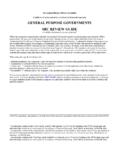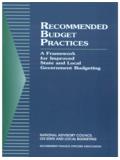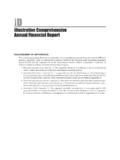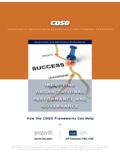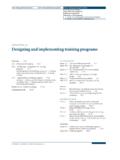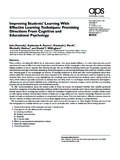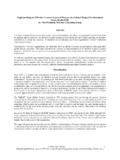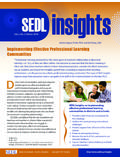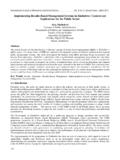Transcription of IMPROVING PERFORMANCE WITH LEAN …
1 The 8 Sources of Waste and How to Eliminate Them IMPROVING PERFORMANCE with lean management TECHNIQUESBY SHAYNE KAVANAGH AND DAVID KRINGSD ecember 2011 | Government Finance Review 19 Waste makes organizations less able to achieve their objectives; it uses limited resources in ways that do not contribute to the organization s overall goals. lean is an organizational PERFORMANCE management system characterized by a collaborative approach between employ-ees and managers to identify and minimize or eliminate activities that do not create value for the customers of a busi-ness process, or stakeholders. One way lean organizations strive toward their goal of perfection is by remaining con-stantly aware of waste so it can be avoided or eliminated. The lean philosophy identifies eight sources of waste that detract from the value a customer receives from a business process.
2 Educating employees about the eight sources of waste and conducting team-based reviews of business processes to look for and correct them can yield substantial benefits. The purpose of this article is to describe and illustrate the eight forms of waste as well as the means of eliminating them. A primary example is a recent project undertaken by the City of Bloomington, Illinois, to apply lean principles to the city s central cash receiving E IGHT S OURCES OF WASTE AND THE CITY OF BLOOMINGTONThe lean philosophy holds that there are eight forms of waste that commonly afflict business processes. The City of Bloomington, Illinois recently undertook a project to apply lean principles to the central cash receiving function of their city and address sources of waste. The project started with a half-day team meeting, where Bloomington staff learned about the eight sources of waste and discussed potential waste in the city s cash receipting process, as well as opportunities to eliminate them.
3 The staff built on this discussion by graphically mapping out the cur-rent process and further specifying where waste might exist and what the remedies might be. They then designed a new process and agreed on the actions they would take to make the new process a reality. This article will focus on the eight sources of waste, including illustrations from Bloomington s experiences and les-sons for other public agencies to consid-er (if you would like to learn more about the lean approach, please see GFOA and TechSolve s free research report1). The eight sources of waste that will be discussed in this article are: defects; rework and correction; inspection and checking; waiting; inventory/backlog; trans-port; over processing; and underutilizing people s Defects.
4 Ideally, in any process, work is performed cor-rectly the first time. A defect happens when incorrect or incomplete work is sent to the next step in the process or to the customer. Avoiding defects starts with understanding the customer s definition of service quality. Quality management guru Joseph Juran defined quality as a product or service s fitness for a customer s intended Using this assumption, if a government does not have a deep understanding of what a customer wishes to accomplish, then producing a high-quality product with no defects will be impossible. Bloomington identified three types of customers (stakeholders) and their requirements:n The Citizen. The primary customer is the citizen, who wants satisfaction; fair treatment; accuracy; and The City Council.
5 Council members want satisfied citi-zens and assurance that the process protects against risks from fraud, abuse, and unintentional Other Departments. Other departments ( , water, police) want accurate revenue recogni-tion and meaningful the customer s definition of quality is understood, the process must be controlled to consistently deliv-er services that are free from defect. In 1924, physicist Walter Shewhart was working to address the issues of qual-ity and excessive variation, and hence One way lean organizations strive toward their goal of perfection is by remaining constantly aware of waste so it can be avoided or lean PhilosophyMany people associate lean with tools for mapping business processes, identifying improvements, and charting progress.
6 However, lean is an attitude and philosophy about con-tinuous improvement and striving for a state of perfection, where every action creates value for customers and citizens. Perfection is an unobtainable ideal, of course, but the lean organization is always looking for ways to do things better. 20 Government Finance Review | December 2011waste, in manufacturing He theorized that any human activity produces variation (since nothing can be done twice with exactly the same effect), but that by under-standing variation we can manage it, and thus manage waste. This concept was expounded on by service quality guru W. Edwards Deming, who worked with Shewhart, in Deming s famous management philosophy. Deming said that variation is the enemy of quality. 5 Variation can result from inadequate training or work instruc-tions, or simply human error.
7 When used properly, tech-nology eliminates the need for human intervention in the business process, which is the primary source of variation. For example, Bloomington considered scanning checks in order to deposit them electronically, thereby eliminating a great deal of physical handling. The new ERP system was also found to have great potential for electronically storing and transferring records for credit cards, parking fines, and utility payments. Even without new technology, however, there are many ways to reduce variation. Later in this article is a discussion on eliminating the inspection and checking wastes by increasing consistency through better controls and and Correction. The second type of waste, rework and correction, is closely related to defects because a defect often requires correction.
8 Rework also includes repeat-ing a process step unnecessarily for example, creating multiple copies of the same form or entering the same data into different systems. Bloomington found that its back-office finance staff was recreating the cashiering staff s spreadsheet in order to balance cash with the receipts for each deposit. During the process review, staff concluded that a common spreadsheet with features that would satisfy the needs of both groups could save a lot of effort. Optimizing the front end of a process is essential to mini-mizing rework. If the form, application, or other item that initiates a process is flawed, it could affect many later points in the process. Providing customers with very clear and con-cise instructions can help ensure that the application is filled out correctly in the first place.
9 Technology can also be used to reduce variation in initial intake. For example, payments might be electronically scanned, thereby removing human error from the data entry process. Inspection and Checking. A process should produce reli-able results the first time work is performed. Hence, inspec-tion or double-checking (or triple or quadruple checking) is considered a potential form of a waste. For example, requiring Technology: The Solution to Waste? Bloomington undertook a lean process review as it was implementing a new enterprise resource planning (ERP) sys-tem. The intent of doing the review and the implementation concurrently was to optimize the use of the new technol-ogy by considering it as part of a broader process review. Bloomington was in Phase I of the ERP implementation, so members of the lean team were reasonably familiar with the technology.
10 Only 20 to 25 percent of the suggestions for IMPROVING the process related directly to the new ERP tech-nology, while the rest related to low- or no-tech ideas for IMPROVING how employees interacted with each other or with the public. The fact that the majority of ideas for improvement were not related to the new technology is not an indictment of the technology or how well staff understands it; to the contrary, staff saw the new technology as very important, and were enthusiastic about its potential. However, this example illustrates a common result of process improvement projects, which is that technology is not typically the primary concern when it comes to process effectiveness. Technology usu-ally ranks third, after the effective deployment of the people who participate in the process and how the process itself is designed.

